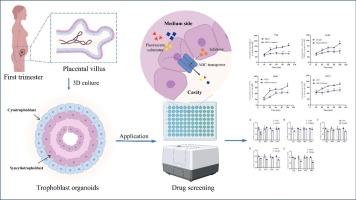人类滋养层有机体用于改进对胎盘 ABC 转运体介导的药物转运的预测
IF 3.3
3区 医学
Q2 PHARMACOLOGY & PHARMACY
引用次数: 0
摘要
ATP结合盒(ABC)转运体是重要的跨膜外排转运体,在胎盘屏障中发挥着不可替代的作用。临床药物的处置和药物相互作用也与 ABC 转运体的功能密切相关。滋养层细胞是胎盘的一个独特特征,对孕期正常胎盘的形成和维持至关重要。ABC 转运体在胎盘合胞滋养层中大量表达,尤其是 P-gp、BCRP 和 MRPs。然而,由于缺乏适当的模型系统,ABC 转运体与滋养细胞之间的分子调控机制仍不清楚。本报告从人类胎盘绒毛中培养出滋养层有机体,并将其培养成具有空腔的三维结构。滋养层有机体表现出与绒毛组织相当的转运体表达和定位,表明其与药物转运模型的生理相关性。此外,荧光底物可在器官组织中聚集,并被抑制剂选择性抑制,这表明器官组织中的ABC转运体(P-gp、BCRP、MRP1和MRP2)具有外流功能。为了进一步验证这种药物转运模型,我们选择了两种常用的高血压药物和三种抗精神病药物,它们对 ABC 转运体都有不同程度的抑制作用。总之,基于人滋养细胞器官组织成功建立了一个由ABC转运体介导的新药物转运模型,可用于研究胎盘中的药物转运。本文章由计算机程序翻译,如有差异,请以英文原文为准。

Human trophoblast organoids for improved prediction of placental ABC transporter-mediated drug transport
ATP-binding cassette (ABC) transporters, the important transmembrane efflux transporters, play an irreplaceable role in the placenta barrier. The disposition and drug-drug interaction of clinical drugs are also closely related to the functions of ABC transporters. The trophoblast is a unique feature of the placenta, which is crucial for normal placentation and maintenance during pregnancy. ABC transporters are abundantly expressed in placental syncytiotrophoblast, especially P-gp, BCRP, and MRPs. However, due to the lack of appropriate modeling systems, the molecular mechanisms of regulation between ABC transporters and trophoblast remains unclear. In this report, trophoblast organoids were cultured from human placental villi and developed into three-dimension structures with cavities. Trophoblast organoids exhibited transporter expression and localization comparable to that in villous tissue, indicating their physiological relevance for modeling drug transport. Moreover, fluorescent substrates can accumulate in organoids and be selectively inhibited by inhibitors, indicating the efflux function of ABC transporters (P-gp, BCRP, MRP1, and MRP2) in organoids. Two commonly used hypertension drugs and three antipsychotics were chosen to further validate this drug transport model and demonstrate varying degrees of inhibitory effects on ABC transporters. Overall, a new drug transport model mediated by ABC transporter has been successfully established based on human trophoblast organoids, which can be used to study drug transport in the placenta.
求助全文
通过发布文献求助,成功后即可免费获取论文全文。
去求助
来源期刊
CiteScore
6.80
自引率
2.60%
发文量
309
审稿时长
32 days
期刊介绍:
Toxicology and Applied Pharmacology publishes original scientific research of relevance to animals or humans pertaining to the action of chemicals, drugs, or chemically-defined natural products.
Regular articles address mechanistic approaches to physiological, pharmacologic, biochemical, cellular, or molecular understanding of toxicologic/pathologic lesions and to methods used to describe these responses. Safety Science articles address outstanding state-of-the-art preclinical and human translational characterization of drug and chemical safety employing cutting-edge science. Highly significant Regulatory Safety Science articles will also be considered in this category. Papers concerned with alternatives to the use of experimental animals are encouraged.
Short articles report on high impact studies of broad interest to readers of TAAP that would benefit from rapid publication. These articles should contain no more than a combined total of four figures and tables. Authors should include in their cover letter the justification for consideration of their manuscript as a short article.

 求助内容:
求助内容: 应助结果提醒方式:
应助结果提醒方式:


